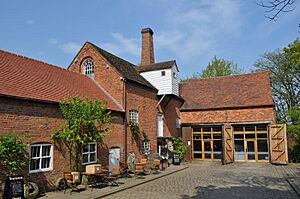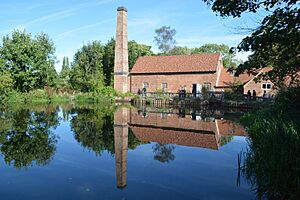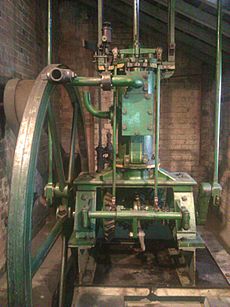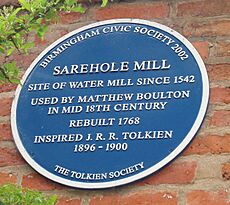Sarehole Mill facts for kids
Quick facts for kids Sarehole Mill |
|
|---|---|

Sarehole Mill
|
|
| Location | Hall Green, Birmingham |
| OS grid reference | SP1005381833 |
| Area | West Midlands |
| Built | 1771 |
| Governing body | Birmingham Museums Trust |
| Owner | Birmingham Museums trust |
|
Listed Building – Grade II
|
|
| Official name: Sarehole Mill | |
| Designated | 25 April 1952 |
| Reference no. | 1075631 |
| Lua error in Module:Location_map at line 420: attempt to index field 'wikibase' (a nil value). | |
Sarehole Mill is an old water mill located in Hall Green, Birmingham, England. It sits on the River Cole. Today, it is a museum run by the Birmingham Museums Trust.
Sarehole Mill is famous for its connection to the author J. R. R. Tolkien. It is also one of only two working water mills left in Birmingham. The other is New Hall Mill in Walmley.
Contents
History of Sarehole Mill
When the Mill Was Built
Sarehole Mill was first built in 1542. It was constructed on the site of an even older mill. For a time, it was known as Bedell's or Biddle's Mill. This name came from an early owner. Later, in 1727, people called it High Wheel Mill.
Early Uses of the Mill
Around 1755, a famous inventor named Matthew Boulton leased the mill. He was a key figure in the Industrial Revolution. He was also part of the Lunar Society, a group of scientists. It is thought that Boulton changed the mill's machines. He used them for working with metal.
Over the years, Sarehole Mill did many jobs. It ground grain to make flour. It also ground bones to create fertiliser. The mill was used for rolling metal and sharpening tools. It even helped in drawing wire.
Restoring the Mill
The building you see today was built in 1771. It continued to operate until 1919. After that, the mill became old and broken down. People in the local community wanted to save it. They started a campaign when there was talk of tearing it down. Their efforts worked, and the mill was restored in 1969.
In April 2012, the millpond was emptied. This was done to fix the sluice gates. These gates control the water flow. In the winter of 2012–13, the pond was cleaned. It had a lot of mud and dirt at the bottom.
Recent Updates and Activities
Between 2012 and 2013, Sarehole Mill had a big makeover. About £375,000 was spent on repairs. The roof, chimney, and millpond were fixed. The water wheel and machinery were also repaired. This allowed the mill to grind flour again.
A new outdoor bread oven was built. It is used regularly to bake bread. This bread is made with flour ground right at the mill. Sarehole Mill has many volunteers. There are 10 volunteer millers. There are also 15 volunteer gardeners and eight volunteer guides. In 2019, over 14,000 people visited the site.
In 2019, floods caused damage. This stopped the mill from grinding flour. Repairs started soon after the flood. In February 2020, the mill's old Victorian bakery was fixed up. A new, modern bakery was also added. Baked goods are now sold in the Millers Tea Room. The old bakery is used to show how bread was made long ago.
During the COVID-19 pandemic, the mill closed for a while. This was like all places managed by the Birmingham Museums Trust. However, it has since reopened to visitors. You can visit the mill by taking a guided tour. There are also special tours called "Origins of Middle Earth." These tours explore the area's connections to J. R. R. Tolkien.
Sarehole Mill's Steam Engine
In 1852, a steam engine was added to Sarehole Mill. It helped the water wheels power the mill. Water was the main power source. But the steam engine made sure the mill could keep working. It would run even if there wasn't enough water.
The original steam engine is no longer there. The current engine is similar in size. It is a single-cylinder table engine. It has 16 horsepower. Its maker is unknown, and it does not work right now.
This engine was put in during the mill's restoration in 1975. It used to belong to a sweet company. That company was called Smith Kendon Ltd. They used it in their factories until 1948. In 1952, it was given to the Birmingham Museum of Science and Industry. Later, it was moved to Sarehole Mill.
J. R. R. Tolkien's Connection
The famous author J. R. R. Tolkien lived very close to Sarehole Mill. He lived there between the ages of four and eight. He would have seen the mill from his house. At that time, the area was mostly farmland and countryside.
Tolkien said that he used Sarehole Mill as an idea for a place in his book, The Lord of the Rings. This place was the Mill at Hobbiton. In an interview in 1966, Tolkien described the area:
It was a kind of lost paradise... There was an old mill that really did grind corn with two millers, a great big pond with swans on it, a sandpit, a wonderful dell with flowers, a few old-fashioned village houses and, further away, a stream with another mill. I always knew it would go – and it did.
Sarehole Mill is now part of the Shire Country Park.
See also
 In Spanish: Molino de Sarehole para niños
In Spanish: Molino de Sarehole para niños




